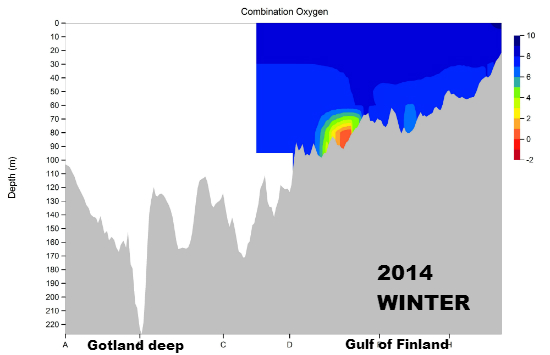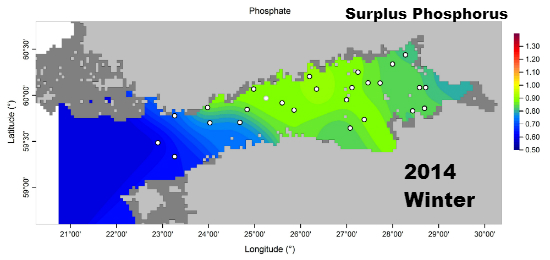Press release 2014-01-23 at 15:48
Press release by Finnish Environment Institute and Ministry of the Environment
The oxygen conditions in various parts of the Gulf of Finland has improved clearly since the poor situation in late summer and early autumn of 2013. These good news were reported in the opening event of the Gulf of Finland Year based on the data obtained by the Finnish Environment Institute's marine research vessel, Aranda. Thanks to the Gulf of Finland Year co-operation between Finland, Estonia and Russia, Aranda was able to visit more research points on the Gulf of Finland than previously.
The phosphate phosphorus concentration of the surface layer on the Gulf of Finland is now close to the lowest values measured in the 21st century. In part, the weather type that has prevailed over the autumn and early winter with strong winds from the south and west has helped the situation. These winds have mixed the ice-free water of the Gulf of Finland well and this is now visible in the measurement results.
Research co-operation introduces concrete results
Minister of the Environment Ville Niinistö who spoke at the opening event of the Gulf of Finland Year in the afternoon, emphasised the importance of co-operation. “A unique research programme involving three countries will be implemented during the Gulf of Finland Year. The most important goal is to relay the latest information from the researchers to the political decision-makers and produce concrete solution suggestions. I hope that the research information will be utilised even more than before in connection with decisions pertaining to the Baltic Sea,” stated Niinistö. “For example, the case of a phosphorus release to the river Luga, thanks to research information and the resulting public discussion, action was taken and notable results were achieved.”
The practical co-operation of the Gulf of Finland Year has already taken off to a good start. Last week, Aranda had Russian researchers on-board and samples were collected with them from more points than before at the eastern part of the Gulf of Finland. In addition, Finland, Estonia and Russia have produced and will implement a co-operation programme related to the monitoring of the Gulf of Finland's condition. “Finland, Estonia and Russia will improve the monitoring of the Gulf of Finland. An extensive, common observation network is in the works. This can be used to produce comparable information on the condition of the sea using standard measurements and methods,” says Niinistö.
Warm and windy winter has improved the condition of the Gulf of Finland
Thanks to the strong winds from the south and west which have continued from November through to January, the oxygen concentration in the sub-basins of the Gulf of Finland has improved. In addition, by January, no ice cover had been formed on the Gulf of Finland. Thanks to the winds, the tongue of salty deep water with weak oxygen concentration that extended from the Baltic Proper far into the Gulf of Finland has withdrawn west. This has enabled proper mixing of the water masses in areas shallower than 80 metres. A similar period of weak oxygen concentration that was seen during last summer and early autumn has prevailed several times before on the Gulf of Finland during the 21st century.
“At times, the heavy, salty and anoxic deep water of the Baltic Sea manages to flow in to the Gulf of Finland. In situations like these, when the water layer close to the bottom becomes oxygen-free, phosphorus may be released from the bottom sediment and end up to the surface waters as a consequence of the waters mixing. This is not the case at the moment, however, so this phenomenon known as internal loading has not increased the amount of phosphorus on the Gulf of Finland”, explains Juha Flinkman, Chief scientist from the Finnish Environment Institute.
The phosphate phosphorus concentration of the surface layer on the Gulf of Finland is now close to the lowest values measured in the 21st century. However, based on several years of monitoring, a downward trend is not yet visible in the concentrations.

Figure 1. Oxygen levels from the Gotland deep to the Gulf of Finland in winter 2014

Figure 2. Surplus phosphorus in the Gulf of Finland in winter 2014
The Opening Event of the Gulf of Finland Year focused on sustainable solutions
The official opening of the Gulf of Finland year took place on 21 January 2014 at the Helsinki City Hall in the form of two expert seminars and an Opening Forum. The Cities Forum seminar invited local Baltic Sea action groups to join in for a discussion of concrete water resources protection measures, and their benefits and costs. In addition, the common Baltic Sea Action Plan of Helsinki and Turku was published in the morning. The Marine Science for the Society seminar offered an overview of the current status of the Gulf of Finland and the related research, an analysis of the gaps in research data, and a summary of the research data needed in support of decision-making. In the Opening Forum in the afternoon, decision-makers from Finland, Estonia and Russia addressed the subject of sustainable use of the Gulf of Finland. The event was ended by a panel discussion in which operators from a range of fields considered the best protection measures for the Gulf of Finland.
The Gulf of Finland Year is a joint project between Finland, Estonia and Russia to take swift action to improve the condition of the Gulf of Finland. The theme year consists of research cooperation, environmental status monitoring of the sea, a joint environmental education programme and numerous public events. The year will end with the signing of the Gulf of Finland Declaration by Finland, Estonia and Russia. The Declaration outlines the key steps to safeguard sustainable use of the Gulf. The Presidents of Finland, Estonia and Russia are the patrons for the theme year.
Further information
Finnish Environment Institute (SYKE)
Juha Flinkman, HRD Manager, Chief Scientist
firstname.lastname@ymparisto.fi
Tel. 0295 251 115
Kai Myrberg, Leading Researcher, Project Manager for the Gulf of Finland Year 2014
firstname.lastname@ymparisto.fi
Tel. 0295 251 441
Seppo Knuuttila, Senior Research Scientist
firstname.lastname@ymparisto.fi
Tel. 0295 251 286
Saara Reinimäki, Communication Specialist
firstname.lastname@ymparisto.fi
Tel. 0295 251 613
Ministry of the Environment
Ulla Ahonen, Communication Specialist
firstname.lastname@ymparisto.fi
Tel. 0295 250 052